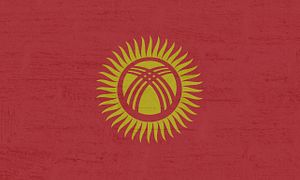Once more, a gold mine in Kyrgyzstan has served as a flashpoint for tensions between locals and outsiders.
On Monday, August 5, an crowd of local Kyrgyz gathered near the Solton-Sary gold mine in eastern Kyrgyzstan. RFE/RL estimated the crowd’s size as 500, while the AFP used a more conservative figure of 300. A brawl ensued between the locals and employees of the company. According to the AFP, 19 company employees and one local villager were hospitalized after the fight, which started with shouting and rock throwing and descended from there. RFE/RL, citing the Kyrgyz Health Ministry, said 20 Chinese workers were hospitalized
The mine is operated by Zhong Ji Mining Company, a Chinese firm. The firm won a contract to develop the Solton-Sary site in 2012 but had a separate contract to explore the site as of 2009.
The latest brouhaha has roots in recent accusations by locals that the mine’s activities were poisoning the environment, leading to the deaths of livestock. There were also complaints about blasting and air quality. As Kaktus, a Kyrgyz news outlet, reported, in mid-July photos and videos of dead sheep appeared in several local-oriented Facebook groups. In late July, the company reportedly agreed to pay compensation to locals for the deaths of livestock even though state inspections indicated that the livestock deaths were not attributable to the mine.
These measures have not satisfied local residents, who demand that work stop and the company’s equipment be removed.
The recent large gathering on August 5 was prefaced by a fight on August 2 in which local media reported two Kyrgyz were injured. The local version posits a pair of locals set upon by more than a dozen Chinese workers; the company version depicts the two locals as drunks who got into a fight with a handful of workers.
These are not the first incidents at Solton-Sary, either. In 2011, a crowd of 300 gathered outside the mining company’s headquarters and in the ensuing fight three policemen and three Chinese miners were beaten. The complaints then were that the company was ignoring environmental standards and treated Kyrgyz workers poorly. In 2011, according to an RFE/RL report, “Prime Minister Almazbek Atambaev said during the discussion that foreign investors’ security should be guaranteed.”
This time around, Prime Minister Mukhammedkaly Abylgaziev is urging much the same: holding investors responsible but also respecting their rights.
While the current tension involves a Chinese company — dovetailing with general concerns about Beijing’s rising influence in the region and extant undercurrents of anti-Chinese sentiment — previous similar episodes involved other mines and non-Chinese companies. For example, in 2013 more than 50 were injured in a violent clash at the Kumtor gold mine, operated by a Canadian firm, following growing protests.
One important difference, however, is how the Chinese government, in contrast to the Canadian government, responds to its companies running into difficulties abroad. On August 6, after the brawl at the mine, the Chinese embassy in Kyrgyzstan issued a statement calling on Bishkek to punish the villagers involved.
Even if these tensions are less rooted in the specific ethnicity of the mining company owners or workers and more so in a different range of issues — valid environmental concerns and questions of who really gets rich from these mines (hint: not the locals) — the greater presence of Chinese companies does raise the profile of such incidents, lending a geopolitical flavor.
Zhong Ji reportedly plans to build a processing facility this year, meaning an uptick in work and likewise an uptick of protests against its operations.

































